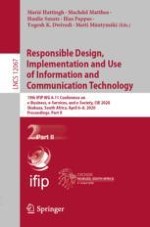2020 | OriginalPaper | Buchkapitel
An Analysis of Problematic Media Use and Technology Use Addiction Scales – What Are They Actually Assessing?
verfasst von : Adrian Abendroth, Douglas A. Parry, Daniel B. le Roux, Jana Gundlach
Erschienen in: Responsible Design, Implementation and Use of Information and Communication Technology
Aktivieren Sie unsere intelligente Suche, um passende Fachinhalte oder Patente zu finden.
Wählen Sie Textabschnitte aus um mit Künstlicher Intelligenz passenden Patente zu finden. powered by
Markieren Sie Textabschnitte, um KI-gestützt weitere passende Inhalte zu finden. powered by
